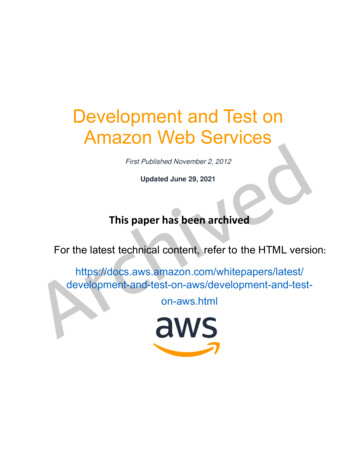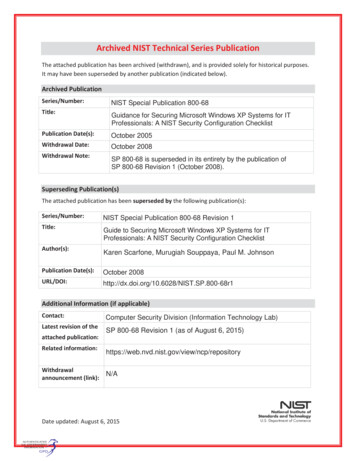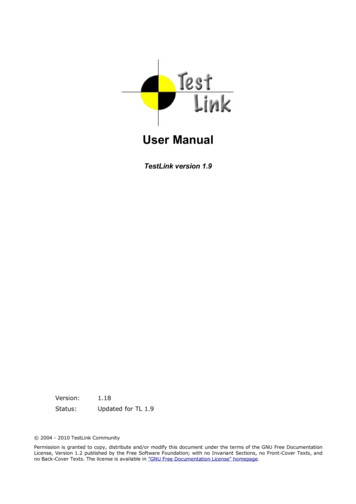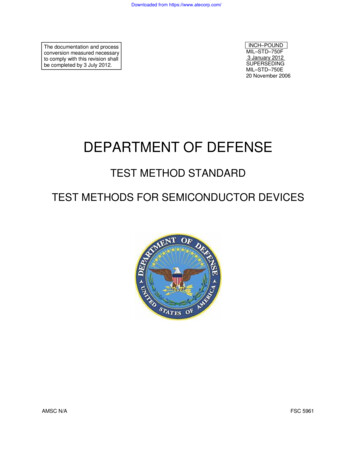
Transcription
Development and Test onAmazon Web ServicesFirst Published November 2, 2012Updated June 29, 2021This paper has been archivedFor the latest technical content, refer to the HTML eston-aws.html
NoticesCustomers are responsible for making their own independent assessment of theinformation in this document. This document: (a) is for informational purposes only, (b)represents current AWS product offerings and practices, which are subject to changewithout notice, and (c) does not create any commitments or assurances from AWS andits affiliates, suppliers or licensors. AWS products or services are provided “as is”without warranties, representations, or conditions of any kind, whether express orimplied. The responsibilities and liabilities of AWS to its customers are controlled byAWS agreements, and this document is not part of, nor does it modify, any agreementbetween AWS and its customers. 2021 Amazon Web Services, Inc. or its affiliates. All rights reserved.This paper has been archivedFor the latest technical content, refer to the AWSWhitepapers & Guides page:https://aws.amazon.com/whitepapers
ContentsIntroduction .1Development phase .2Source code repository .3Project management tools .3On-demand development environments .6Integrating with AWS APIs and IDE enhancements .9Build phase .10Schedule builds .10On-demand builds .10Storing build artifacts .12Testing phase .13Automating test environments .13This paper has been archivedLoad testing .15User acceptance testing .18For the latest technical content, refer to the AWSWhitepapers & Guides page:Fault-tolerance y-side testing.19Resource management .21Cost allocation and multiple AWS accounts .21Conclusion .22Contributors .23Further reading .23Document revisions .23
AbstractThis whitepaper describes how Amazon Web Services (AWS) adds value in the variousphases of the software development cycle, with specific focus on development and test.For the development phase, this whitepaper: Shows you how to use AWS for managing version control Describes project management tools, the build process, and environmentshosted on AWS Illustrates best practicesFor the test phase, this whitepaper describes how to manage test environments and runvarious kinds of tests, including load testing, acceptance testing, fault tolerance testing,and so on.AWS provides unique advantages in each of these scenarios and phases, enabling youto choose the ones most appropriate for your software development project. Theintended audiences for this paper are project managers, developers, testers, systemsarchitects, or anyone involved in software production activities.This paper has been archivedFor the latest technical content, refer to the AWSWhitepapers & Guides page:https://aws.amazon.com/whitepapers
Amazon Web ServicesDevelopment and Test on Amazon Web ServicesIntroductionOrganizations write software for various reasons, ranging from core business needs(when the organization is a software vendor) to customizing or integrating software.Organizations also create different types of software: web applications, standaloneapplications, automated agents, and so on. In all such cases, development teams arepushed to deliver software of high quality as quickly as possible to reduce the time tomarket or time to production.In this document, “development and test” refers to the various tools and practicesapplied when producing software. Regardless of the type of software to be developed, aproper set of development and test practices is key to success. However, producingapplications not only requires software engineers, but also IT resources, which aresubject to constraints like time, money, and expertise.The software lifecycle typically consists of the following main elements:This paper has been archivedFor the latest technical content, refer to the AWSWhitepapers & Guides page:https://aws.amazon.com/whitepapersElements of the software lifecycle1
Amazon Web ServicesDevelopment and Test on Amazon Web ServicesThis whitepaper covers aspects of the development, build, and test phases. For each ofthese phases, you need different types of IT infrastructure. AWS provides multiplebenefits to software development teams. AWS offers on-demand access to a widerange of cloud infrastructure services, charging only for the resources that are used.AWS helps eliminate both the need for costly hardware and the administrative pain thatgoes with owning and operating it.Owning hardware and IT infrastructure usually involves a capital expenditure for a 3-5year period, where most development and test teams need compute or storage forhours, days, weeks, or months. This difference in timescales can cause friction due tothe difficulty for IT operations to satisfy simultaneous requests from project teams, evenas they are constrained by a fixed set of resources. The result is that project teamsspend a lot of time justifying, sourcing, and holding on to resources. This time could bespent focusing on the main job.By provisioning only the resources needed for the duration of development phases, testruns, or complete test campaigns, your company can achieve important savingscompared to investing up front in traditional hardware. With the right level of granularity,you can allocate resources depending on each project’s needs and budget. In additionto those economic benefits, AWS also offers significant operational advantages, suchas the ability to set up a development and test infrastructure in a matter of minutesrather than weeks or months, and to scale capacity up and down to provide the ITresources Forneeded,when technicalthey are needed.theonlylatestcontent, refer to the AWSThis paper has been archiveditepapers& GuidesThis document highlightsWhsomeof the best practicesand page:recommendations arounddevelopment and https://aws.amazon.com/whitepaperstest on AWS. For example, for the development phase, this documentdiscusses how to securely and durably set up tools and processes such as versioncontrol, collaboration environments, and automated build processes. For the testingphase, this document discusses how to set up test environments in an automatedfashion, and how to run various types of tests, including side-by-side tests, load tests,stress tests, resilience tests, and more.Development phaseRegardless of team size, software type being developed, or project duration,development tools are mandatory to rationalize the process, coordinate efforts, andcentralize production. Like any IT system, development tools require properadministration and maintenance. Operating such tools on AWS not only relieves yourdevelopment team from low-level system maintenance tasks such as networkconfiguration, hardware setup, and so on, but also facilitates the completion of more2
Amazon Web ServicesDevelopment and Test on Amazon Web Servicescomplex tasks. The following sections describe how to operate the main components ofdevelopment tools on AWS.Source code repositoryThe source code repository is a key tool for development teams. As such, it needs to beavailable, and the data it contains (source files under version control) needs to bedurably stored, with proper backup policies. Ensuring these two characteristics—availability and durability—requires resources, expertise, and time investment thattypically aren’t a core competency of a software development team.Building a source code repository on AWS involves creating an AWS CodeCommitrepository. AWS CodeCommit is a secure, highly scalable, managed source controlservice that hosts private GitHub repositories. It eliminates the need for you to operateyour own source control system, and there is no hardware to provision and scale orsoftware to install, configure, and operate.You can use CodeCommit to store anything from code to binaries, and it supports thestandard functionality of GitHub, allowing it to work seamlessly with your existingGitHub-based tools. Your team can also use CodeCommit’s online code tools tobrowse, edit, and collaborate on projects.This paper has been archivedCodeCommit enables you to store any number of files, and there are no repository sizethe latesttechnicalcontent,aboutreferto the AWSlimits. In a Forfew simplesteps, youcan find informationa repositoryand clone it toyour computer, creating aWhlocalitrepositoryyou can page:make changes and then pushepaperswhere& Guidesthem to the CodeCommit repository. You can work from the command line on your localhttps://aws.amazon.com/whitepapersmachines or use a GUI-based editor.Project management toolsIn addition to the source code repository, teams often use additional tools such as issuetracking, project tracking, code quality analysis, collaboration, content sharing, and soon. Most of the time, those tools are provided as web applications. Like any otherclassic web application, they require a server to run, and frequently a relationaldatabase. The web components can be installed on Amazon Elastic Compute Cloud(Amazon EC2), with the database using Amazon Relational Database Service (AmazonRDS) for data storage.Within minutes, you can create Amazon EC2 instances, which are virtual machines overwhich you have complete control. A variety of different operating systems anddistributions are available as Amazon Machine Images (AMIs). An AMI is a template3
Amazon Web ServicesDevelopment and Test on Amazon Web Servicesthat contains a software configuration (operating system, application server, andapplications) that you can run on Amazon EC2. After you’ve properly installed andconfigured the project management tool, AWS recommends you create an AMI fromthis setup so you can quickly recreate that instance without having to reinstall andreconfigure the software.Project management tools have the same needs as source code repositories: they needto be available, and data has to be durably stored. While you can mitigate the loss ofcode analysis reports by recreating them against the desired repository version, losingproject or issue tracking information might have more serious consequences. You canaddress the availability of the project management web application service by usingAMIs to create replacement Amazon EC2 instances in case of failure.You can store the application’s data separately from the host system to simplifymaintenance or migration operations. Amazon Elastic Block Store (Amazon EBS)provides off-instance storage volumes that persist independently from the life of aninstance. After you create a volume, you can attach it to a running Amazon EC2instance. As such, an Amazon EBS volume is provisioned and attached to the instanceto store the data of the version control repository.This paper has been archivedYou achieve durability by taking point-in-time snapshots of the EBS volume containingthe repository data. EBS snapshots are stored in Amazon Simple Storage Service(Amazon S3), a highly durable and scalable data store. Objects in Amazon S3 areFor the latest technical content, refer to the AWSredundantly stored on multiple devices across multiple facilities in an AWS Region. Youepapers &ofGuidescan automate the creationWhanditmanagementsnapshotspage:using Amazon Data sThese snapshots can be used as the starting point for new Amazon EBS volumes, andcan protect your data for long-term durability. In case of a failure, you can recreate theapplication data volume from the snapshots, and recreate the application instance froman AMI.To facilitate proper durability and restoration, Amazon Relational Database Service(Amazon RDS) offers an easy way to set up, operate, and scale a relational database inAWS. It provides cost-efficient and resizable capacity while managing time-consumingdatabase administration tasks, freeing the project team from this responsibility. AmazonRDS Database instances (DB instances) can be provisioned in a matter of minutes.Optionally, Amazon RDS will ensure that the relational database software stays up todate with the latest patches. The automated backup feature of Amazon RDS enablespoint-in-time recovery for DB instances, allowing restoration of a DB instance to anypoint in time within the backup retention period.4
Amazon Web ServicesDevelopment and Test on Amazon Web ServicesAn Elastic IP address provides a static endpoint to an Amazon EC2 instance, and canbe used in combination with DNS (for example, behind a DNS CNAME). This helpsteams to access their hosted services, such as the project management tool, in aconsistent way, even if infrastructure is changed underneath; for example, when scalingup or down, or when a replacement instance is provisioned.This paper has been archivedAn Elastic IP Address provides a static endpoint to an Amazon EC2 instanceFor the latest technical content, refer to the AWSNote: For even quickereasier deployment,projectWhiandtepapers& Guidesmanypage:management tools are available from the AWS Marketplace or as Amazonhttps://aws.amazon.com/whitepapersMachine Images.As your development team grows or adds more tools to the project managementinstance, you might require extra capacity for both the web application instance and theDB instance. In AWS, scaling instances vertically is an easy and straightforwardoperation. You simply stop the EC2 instance, change the instance type, and start theinstance.Alternatively, you can create a new web application server from the AMI on a morepowerful Amazon EC2 instance type, and replace the previous server. You can usehorizontal scaling by using Elastic Load Balancing, adding more instances to the systemby using AWS Auto Scaling. In this case, as you have more than one node, you can useElastic Load Balancing to distribute the load across all application nodes. Amazon RDS5
Amazon Web ServicesDevelopment and Test on Amazon Web ServicesDB instances can scale compute and memory resources with a few clicks on the AWSManagement Console.Use Elastic Load Balancing to distribute the load across all application nodesThis paper has been archivedWhen you want to quickly set up a software development project on AWS and don’twant to configure custom project management tools on EC2, you can use AWSCodeStar. ForAWStheCodeStarcomeswith a unifiedproject referdashboardand integrationlatesttechnicalcontent,to theAWS withAtlassian JIRA software, a third-party issue tracking and project management tool. WithWhitepapers& Guidespage:the AWS CodeStar projectdashboard,you caneasily trackyour entire softwaredevelopment process,from a backlog work item to production code mand development environmentsDevelopers primarily use their local laptops or desktops to run their developmentenvironments. This is typically where the integrated development environment (IDE) isinstalled, where unit tests are run, where source code is checked in, and so on.However, there are a few cases where on-demand development environments hostedin AWS are helpful.AWS Cloud9 is a cloud-based IDE that enables you to write, run, and debug your codewith just a browser. It includes a code editor, debugger, and terminal. AWS Cloud9comes prepackaged with essential tools for popular programming languages, includingJavaScript, Python, PHP, Ruby, Go, C , and more, so you don’t need to install files orconfigure your development machine to start new projects. Because your AWS Cloud96
Amazon Web ServicesDevelopment and Test on Amazon Web ServicesIDE is cloud-based, you can work on your projects from your office, home, or anywhereusing an internet-connected machine. With AWS Cloud9, you can quickly share yourdevelopment environment with your team, enabling you to pair program and track eachother's inputs in real time.Some development projects may use specialized sets of tools that would becumbersome or resource-intensive to install and maintain these on local machines,especially if the tools are used infrequently. For such cases, you can prepare andconfigure development environments with required tools (development tools, sourcecontrol, unit test suites, IDEs, and so on), and then bundle them as AMIs.You can easily start the right environment and have it up and running in minimal timeand with minimal effort. When you no longer need the environment, you can shut itdown to free up resources. This can also be helpful if you need to switch context in themiddle of having code checked out and work in progress. Instead of managing branchesor dealing with partial check-ins, you can spin up a new temporary environment.On AWS, you have access to a variety of different instance types, some with veryspecific hardware configurations. If you are developing specifically for a givenconfiguration, it may be helpful to have a development environment on the sameplatform where the system is going to run. Amazon WorkSpaces enables you toprovision virtual, cloud-based Microsoft Windows or Amazon Linux desktops for yourusers to run IDEs using your favorite applications such as Visual Studio, IntelliJ,For the latest technical content, refer to the AWSEclipse, AWS CLI, AWS SDK tools, Visual Studio Code, Eclipse, Atom, and many more.This paper has been archivedWhitepapers & Guides page:The concept of hosted desktops is not limited to development environments; it canhttps://aws.amazon.com/whitepapersapply to other rolesor functions as well. For more complex working environments, AWSCloudFormation makes it easy to set up collections of AWS resources. This topic isdiscussed further in the Testing section of this document. In many cases, suchenvironments are set up within the Amazon Virtual Private Cloud (Amazon VPC), whichenables you to extend your on-premises private network to the cloud. You can thenprovision the development environments as if they were on the local network, butinstead they are running in AWS. This can be helpful if such environments require anyon-premises resources such as Lightweight Directory Access Protocol (LDAP).The following diagram shows a deployment where development environments arerunning on Amazon EC2 instances within an Amazon VPC. Those instances areremotely accessed from an enterprise network, through a secure VPN connection.7
Amazon Web ServicesDevelopment and Test on Amazon Web ServicesDevelopment environments running on Amazon EC2 instances within an Amazon VPCStopping vs. ending Amazon EC2 instancesWhenever development environments are not used; for example, during the hours whenyou are not working, or when a specific project is on hold, you can easily shut themdown to save resources and cost. There are two possibilities:This paper has been archived Stoppingthe instances,which is roughlyequivalentto hibernatingthe operatingFor thelatest technicalcontent,referto the AWSsystemWhitepapers & Guides page:Ending thehttps://aws.amazon.com/whitepapersinstances, which is roughly equivalent to discarding the operatingsystemWhen you stop an instance (possible for Amazon EBS backed AMIs), the computeresources are released and no further hourly charges for the instance apply. TheAmazon EBS volume stores the state, and next time you start the instance, it will havethe working data as it did before you stopped it.Note: any data stored on ephemeral drives will not be available after astop/start sequence.When you end an instance, the root device and any other devices attached during theinstance launch are automatically deleted (unless the DeleteOnTermination flag of avolume is set to “false”), meaning that data may be lost if there is no backup orsnapshot available for the deleted volumes. An ended instance doesn’t exist anymore8
Amazon Web ServicesDevelopment and Test on Amazon Web Servicesand must be recreated from an AMI if needed. You would typically end the instance of adevelopment environment if all work has been completed and/or the specificenvironment will not be used anymore.If you use AWS Cloud9 IDE, the EC2 instance that AWS Cloud9 connects to by defaultstops 30 minutes after you close the IDE, and restarts automatically when you open theIDE. As a result, you typically only incur EC2 instance charges for when you are activelyworking.If you chose to run your development environments on EC2 instances, you can useAWS Instance Scheduler to automatically stop your instances during weekends or nonworking schedules. This can help reduce the instance utilization and overall spend.Integrating with AWS APIs and IDE enhancementsWith AWS, you can now code against and control IT infrastructure, either if the targetplatform of your project is AWS, or if the project is about orchestrating resources inAWS. For such cases, you can use the various AWS SDKs to easily integrate theirapplications with AWS APIs, taking the complexity out of coding directly against a webservice interface and dealing with details around authentication, retries, error handling,and so on. The AWS SDK tools are available for multiple languages: C , Go,JavaScript, Node.js, Python, Java, .Net, PHP, Ruby, and for mobile platforms Androidand iOS.This paper has been archivedFor the latest technical content, refer to the AWSAWS also offers IDE toolsWhthatitmakeit easieryou to interactepapers&forGuidespage:with AWS from withinyour IDEs, such as:https://aws.amazon.com/whitepapers AWS Toolkit for Visual Studio AWS Toolkit for VS Code AWS Toolkit for Eclipse AWS Toolkit for IntelliJ IDEA AWS Toolkit for PyCharm AWS Toolkit for Azure DevOps AWS Toolkit for Rider AWS Toolkit for WebStorm9
Amazon Web ServicesDevelopment and Test on Amazon Web ServicesFor developing and building Serverless applications, AWS offers the ServerlessApplication Model (AWS SAM) open-source framework, which can be used with theAWS toolkits mentioned previously.Build phaseThe process of building an application involves many steps, including compilation,resource generation, and packaging. For large applications, each step involves multipledependencies such as building internal libraries, using helper applications, generatingresources in different formats, generating the documentation, and so on.Some projects might require building the deliverables for multiple CPU architectures,platforms, or operating systems. The complete build process can take many hours,which has a direct impact on the agility of the software development team. This impactis even stronger on teams adopting approaches like continuous integration where everycommit to the source repository triggers an automated build, followed by test suites.Schedule buildsThis paper has been archivedTo mitigate this problem, teams working on projects with lengthy build times often adoptthe “nightly build” (or neutral build) approach, or break the project into smaller subprojects (or a combination of both). Doing nightly builds involves a build machineForlatestcontent,to thechecking outthethelatestsourcetechnicalcode from therepository referand buildingthe AWSprojectdeliverables overnight. Developmentteams &maynot buildpage:as many versions as theyWhitepapersGuideswould like, and the build should be completed in time for testing to begin the next day.https://aws.amazon.com/whitepapersBreaking down a project into smaller, more manageable parts might be a solution ifeach sub-project builds faster independently. However, an integration step combining allthe different sub-projects is still often necessary for the team to keep an eye on theoverall project, and to ensure the different parts still work well together.On-demand buildsA more practical solution is to use more computational power for the build process. Ontraditional environments where the build server runs on hardware acquired by theorganization, this option might not be viable due to economic constraints or provisioningdelays. A build server running on an Amazon EC2 instance can be scaled up verticallyin a matter of minutes, reducing build time by providing more CPU or memory capacitywhen needed.10
Amazon Web ServicesDevelopment and Test on Amazon Web ServicesFor teams with multiple builds triggered within the same day, a single Amazon EC2instance might not be able to produce the builds quickly enough. A solution would be totake advantage of the on-demand and pay-as-you-go nature of AWS CodeBuild to runmultiple builds in parallel. Every time a new build is requested by the development teamor triggered by a new commit to the source code repository, AWS CodeBuild creates atemporary compute container of the class defined in the build project and immediatelyprocesses each build as submitted. You can run separate builds concurrently withoutwaiting in a queue. This also enables you to schedule automated builds at a specifictime window.If you use a build tool on EC2 instances running as a fleet of worker nodes, the taskdistribution to the worker nodes can be done using a queue holding all the builds toprocess. Worker nodes pick the next build to process as they are free. To implementthis system, Amazon Simple Queue Service (Amazon SQS) offers a reliable, highlyscalable, hosted queue service. Amazon SQS makes it easy to create an automatedbuild workflow, working in close conjunction with Amazon EC2 and other AWSinfrastructure services. In this setup, developers commit code to the source coderepository, which in turn pushes a build message into an Amazon SQS queue. Theworker nodes poll this queue to pull a message and run the build locally according tothe parameters contained in the message (for example, the branch or source version touse).This paper has been archivedYou can furtherenhancethis setupby dynamicallyadjustingworker nodesFor thelatesttechnicalcontent,referthetopooltheof AWSconsuming the queue. Auto Scaling is a service that makes it easy to scale the numberWhitepapers & Guides page:of worker nodes up or down automatically according to predefined conditions. With Autohttps://aws.amazon.com/whitepapersScaling, worker nodes’capacity can increase seamlessly during demand spikes tomaintain quick build generation, and decrease automatically during demand lulls tominimize costs.You can define scaling conditions using Amazon CloudWatch, a monitoring service forAWS Cloud resources. For example, Amazon CloudWatch can monitor the number ofmessages in the build queue and notify Auto Scaling that more or less capacity isneeded depending on the number of messages in the queue. The following diagramsummarizes this scenario:11
Amazon Web ServicesDevelopment and Test on Amazon Web ServicesAmazon CloudWatch can monitor the number of messages in the build queue and notify AutoScaling that more or less capacity is neededStoring build Thisartifactspaper has been archivedEvery time you produce a build, you need to store the output somewhere. Amazon S3 isan appropriatefor this.technicalInitially, the content,amount of datato betostoreda givenFor servicethe latestreferthe forAWSproject is small, but it grows over time as you produce more builds. Here the pay-asWhitepapers & Guides page:you-go and capacity characteristics of S3 are particularly attractive. When you no longerhttps://aws.amazon.com/whitepapersneed the build output,you can delete it, or use S3’s lifecycle policies to delete or archivethe objects to Amazon S3 Glacier storage class. AWS CodeBuild by default uses S3buckets to store the build outputs.To distribute the build output (for example, to be deployed in test, staging, or production,or to be downloaded to clients), AWS offers several options. You can distribute buildoutput packages directly out of S3 by configuring bucket policies and/or ACLs to restrictthe distribution. You can also share the output object using an S3 presigned URL.A
Amazon Web Services Development and Test on Amazon Web Services 4 that contains a software configuration (operating system, application server, and applications) that you can run on Amazon EC2. After you've properly installed and configured the project management tool, AWS recommends you create an AMI from











